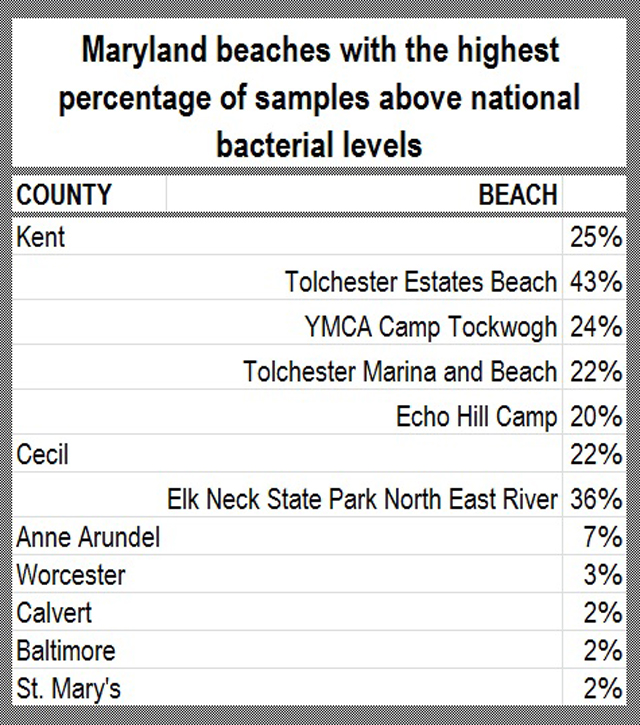WASHINGTON — A report released just in time for the Fourth of July weekend found that Maryland beaches rank 16th among 30 states nationwide for higher bacteria levels than the national health standard. Beach-goers may want to consider Delaware beaches, which were rated fifth best in the country for meeting pollution standards.

Kent County's beaches are the most polluted beaches in Maryland, according to Wednesday's report. (Alexandra Arkin/MNS)
According to the National Resources Defense Council report issued Wednesday, 7 percent of 895 water samples taken from 70 Maryland beaches last year exceeded national daily maximum bacterial standards, . Counties with the highest percent of samples in excess of national standards were Kent (25 percent) and Cecil (22 percent).
In Delaware, 3 percent of the water samples exceeded the standards.
Louisiana, still recovering from the Gulf Coast oil spill, was at the bottom of the list; 37 percent of its samples exceeded the national acceptable bacterial standard. New Hampshire ranked first with only 1 percent of its samples above the national standard.
More than 3,000 beaches were tested across the country. Nationally, the portion of all monitoring samples that exceeded national health standards was 8 percent, up from 7 percent for the previous four years. But the number of beach closings and advisory days, most because of high bacteria levels, rose to 24,091. It was a 29 percent increase from 2009, and the second-highest level in the 21-year history of the Natural Resources Defense Council’s report.
There were 296 beach closings or advisory days in Maryland in 2010, all due to monitoring that revealed elevated bacteria levels. This was more than twice as many as there were in 2009. There were 61 beach closings or advisory days in 2008, but 243 in 2007.
According to David Beckman, director of the Natural Resources Defense Council’s Water Program, American beaches have long suffered from pollution, including bacteria-laden human and animal waste. The main contributors of the contaminants are storm water runoff, sewage overflows and inadequately treated sewage, and agricultural runoff. Other sources include beach-goers themselves, wildlife, septic systems and boating waste.
Another source of water pollution is naturally occurring bacteria, according to Dr. Clifford Mitchell, assistant director for the Office of Environmental Health and Food Protection at the Maryland Department of Health and Mental Hygiene. Last year there were reports about a number of infections associated with Vibrio, an organism naturally present in many waterways, including Maryland water, during the summer when water temperatures rose.
The National Oceanic and Atmospheric Administration has partnered with states including Maryland to develop a new method to help predict when Vibrio bacteria are likely to be present in Chesapeake Bay waters.
Contaminated water creates major health concerns for beachgoers – especially children – including stomach flu, skin rashes, respiratory infections, meningitis, hepatitis and dysentery.
Mitchell said the biggest risk is acute infectious disease. The incidence of people becoming ill after being in contact with or consuming contaminated water is low, but many cases likely go unreported.
The Frederick County Health Department grants permits for operation of two freshwater beaches, the beach at Cunningham Falls State Park and the Baltimore Yearly Meeting of Quakers beach. Both are tested weekly during the summer, said Alicia Evangelista, manager of the Environmental Health Community Services Program at the Frederick County Health Department. The main pollution concern at these beaches is E. coli, but levels have remained very low and neither beach has been closed in the past few years.
The Maryland Departments of the Environment, Natural Resources, and Health and Mental Hygiene work with local health departments to monitor beach quality and safety, said Mitchell. He would not comment on the state’s ranking, but said the important thing is that they make a continuous effort to look at what contributes to the problem of polluted beaches.
While authorities most often issue beach closings and advisories after heavy rains, Mitchell said people should always follow certain safety measures regardless of beach conditions. These include avoiding contact between open sores and water at the beach, and washing hands before and after bathing and before eating.
Busier beaches over the holiday weekend do not mean there is a greater risk of illness. “We want encourage people to use the beaches and take appropriate precautions when they go,” said Mitchell.
The Natural Resources Defense Council advises beachgoers to look for clean beaches and to use common sense. If the water smells or looks strange, don’t go in it.
